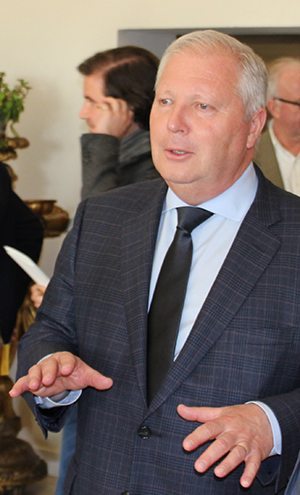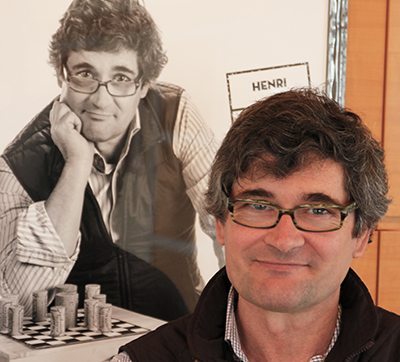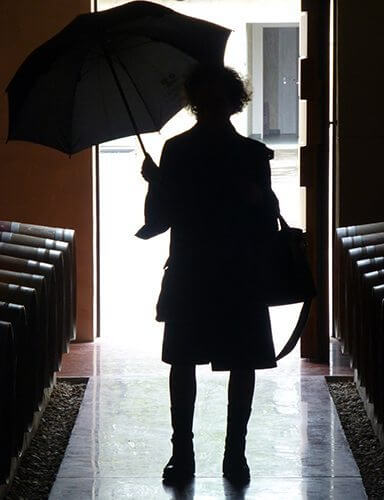The Left bank of the Gironde – the Médoc, encompassing the villages of Margaux, Saint Julien, Pauillac and Saint Estèphe as well as the actual Médoc and Haut Médoc appellations, mostly had a very different experience of the 2015 vintage to the Right bank. Here of course, Cabernet Sauvignon is king, and Merlot, Cabernet Franc and Petit Verdot are in supporting roles.
We always liked to listen to Marcel Ducasse at Château Lagrange, who was always good for a straight answer. When he retired, Bruno Eynard, who had been the maître du chai, took over and continued the tradition. When we tasted the 2009 vintage Bruno told us “We’ve tried to bring a bit of extra finesse and elegance, there is no Petit Verdot, which can fill out a weaker vintage, but which spoils the purity of the Cabernet when it is ripe. This year we were told by new general manager Matthieu Bordes (who has also been at Lagrange for many years, and who is also following the tradition of openness), that he had been told to make the very best wine possible regardless of cost by the owners Suntory, and he was keen to point out that this meant de-selecting some Cabernet that would normally have gone into the Château Lagrange (to the benefit of the second wine Fiefs de Lagrange), but including a relatively huge 10% of Petit Verdot, the highest proportion for ten years. Every Château that we can think of that has Petit Verdot included it in the blend this year. Matthieu was not suggesting his wine was the equal of the 2009 and 2010, but he did add with conviction ‘it’s much better than the 2005’.

Philippe Dhallouin at Mouton
Philippe Dhallouin, who has now done ten years at Mouton Rothshild, was extremely ebullient about the vintage (and with some reason, as his wines, d’Armailhac, and especially Clerc Milon, as well as Mouton all showed very well). We have known him since his previous days at Branaire, he has always been a straight-talker: ‘there were small berries from the outset because of the dryness – and it really was very dry – I feared a repeat of 1995, when the drought made the vines shut down and resulted in blocky tannins. But the August rain helped, just kept the vines photosynthesising, and in September we had 90mm in total which we needed for the vines to finish.’ They had a harvest which lasted four weeks despite the fact that everything had flowered at the same time. He added that on the ‘hot’ terroir of Mouton, mostly facing due south, there was a danger of the grapes getting ‘toasté’ at the end, he had begun harvesting ‘by taste’ about three days before ultimate ripeness to preserve freshness. Mouton is 13.2% this year, while Clerc Milon is 13.4%. So we asked the inevitable ‘which vintage does it most resemble’ question, and Philippe replied that he had got all his technicians together and looked at some vintages he thought might be good to compare it with: 2014 / 2010 / 2009 / 2006 / 2005, and the group were unanimous that the vintages they thought it most like were 2005 and 2009, except for Clerc Milon, which seemed most closely to resemble 2010.

Henri Lurton – Brane Cantenac
Tasting with Henri Lurton at Brane Cantenac, we loved the limpid elegance of the wine. It has a bright a crystalline look and feel, and reminded just how many wines in this vintage have such a feel in the mouth of being emulsions of fine tannins, that when one looks back to the glass one is surprised by the fact the liquid in it is transclucent. Henri was one of several winemakers who told us he was re-grafting and planting more Cabernet Sauvignon as a response to global warming. There was also a little chat about Carmenère, which makes up a tiny 1% of his Grand Vin, Henri telling us that it stays vegetal unless tipping over into overripeness, so he always picks it last. Cabernet on the other hand, never gets overripe, so they pick it at optimal ripeness for colour and structure, and the Carmenère adds a little spice.

Claire Villars as Mary Poppins
At Ferrière, Claire Villars told us with typical frankness ‘I didn’t like the Merlot except in Saint Estèphe’, where she makes Château Domeyne, from vineyards bordering Calon Ségur. She also makes La Gurgue, and Ferrière (biodynamic viticulture) in Margaux, as well as Haut Bages Libéral in Pauillac. Ferrière is a striking success, and with 65% Cabernet Sauvignon this is perhaps unsurprising in this vintage. Other high Cabernet-content Margaux like Rauzan Ségla and Margaux itself show that this is the way to go if global warming is going to continue to produce hotter vintages.
Claire’s husband is Gonzague Lurton, and she also showed us his Durfort Vivens with 90% Cabernet Sauvignon, another good wine with great purity of fruit.
At Branaire Ducru, Jean-Dominique Videau told us that they felt they had made a qualitative success with all the grape varieties, and the blend is 65% CS, 26%M, 5% PV and 4% CF. He was also the only producer who offered to open his 2014 alongside, which was rather fascinating. The 2014 has less body, richness and depth, but it does have a really remarkable vivacity – it is fresh and juicy and gourmand – one wants to swallow. This character of sheer yumminess is, in our view, slightly lacking in a lot of 2015s.